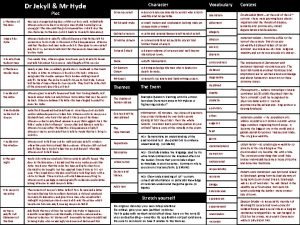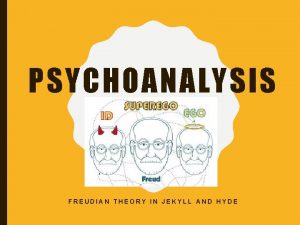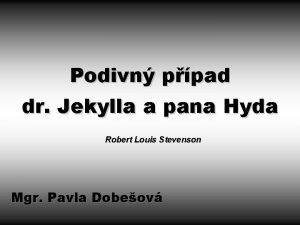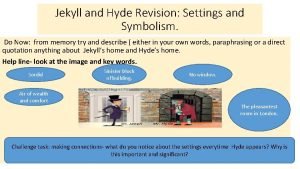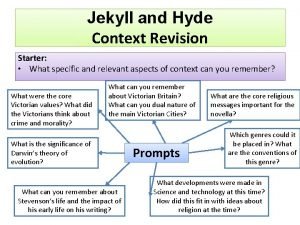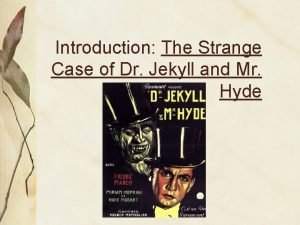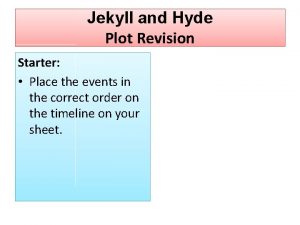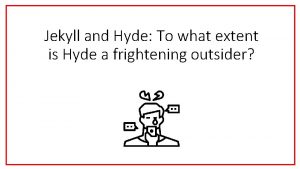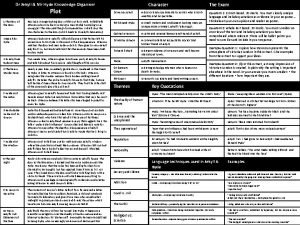Jekyll and Hyde Revision The plot with fill








- Slides: 8

Jekyll and Hyde Revision The plot with fill the blank quotations…good luck!

The ending: very dramatic. How do the characters change/finally end up and what are the overall messages on themes of Respectability? Science? Duality? Repression? One evening, Jekyll's servant comes to Utterson and asks him to come to Jekyll's house. They go to the laboratory, but the door is locked. The voice from inside does not sound like Jekyll's and both men believe it is Hyde. Poole says the voice has for days been crying out for a particular chemical to be brought, but the chemicals given have been rejected as 'not pure'. Poole says that earlier he caught a glimpse of a person in the lab who looked scarcely human ‘a rat’ and fears 'there's blood most foully shed'. They break down the door “if not by fair means, then by foul! if not of your consent, then by brute force‘ and inside find a body, twitching. In its hand are the remains of a test tube (or vial). The body is smaller than Jekyll's but wearing clothes that would fit him a ‘self-destroyer’. On the table is a will dated that day which leaves everything to Utterson, with Hyde's name crossed out. There is also a package containing Jekyll's 'confession' and a letter asking Utterson to read Dr Lanyon's letter which he left after his death and is now in Utterson's safe. Utterson tells Poole he will return before midnight, when he has read all the documents.

Chapter 9 lists the contents of Dr Lanyon's letter. It tells of how Lanyon received a letter from Jekyll asking him to collect a drawer containing chemicals, a vial and a notebook from Jekyll's laboratory and to give it to a man who would call at midnight. ‘if you fail me to-night, I am lost. " � Lanyon says he was curious, especially as the book contained some strange entries � At midnight a man appears. He is small and grotesque, wearing clothes that are too large for him. � The man offers to take the chemicals away, or to drink the potion. ‘if you shall so prefer to choose, a new province of knowledge and new avenues to fame and power shall be laid open to you’ � Lanyon accepts and, before his very eyes, Hyde transforms into none other than Dr Jekyll. "like a man restored from death. —there stood Henry Jekyll!" � In horror at what he has witnessed, Lanyon becomes seriously ill.

Jekyll’s Full Statement of the Case � � � Jekyll tells the story of how he turned into Hyde. It began as scientific curiosity into the 'thorough and primitive duality of man ' the duality of human nature (or the good and evil), and his attempt to separate the 'darker self’ to set him free from its restrictions. However what fristrated him was 'one was wholly evil, and the other was still the old Henry Jekyll' an 'incongruous compound. ' Eventually, however, he became addicted to the character of Hyde, who increasingly took over and destroyed him 'My devil had been long caged, he came out roaring‘ and became impossible to surpress 'the hand that lay on my knee was corded and hairy '. The novel does not return to Utterson who, at the end of Chapter 8, was going to return to Jekyll's house. Instead it concludes: Will Hyde die upon the scaffold? or will he find courage to release himself at the last moment? God knows; I am careless; this is my true hour of death, and what is to follow concerns another than myself. Here then, as I lay down the pen and proceed to seal up my confession, I bring the life of that unhappy Henry Jekyll to an end.

Structure: how does Stevenson use structure to build suspense/tension and to work towards the climax? � Narrative perspective/shifts in perspective: epistolary devices � Setting: 19 th century (modern day at the time). Religious setting. Location itself alluding to duality foreshadowing what is to come. Laboratory setting a place of learning that has become a place of selfish pursuit of scientific glory. The dark of night when the atrocities occur). � Witholding information: revealed in clues/partial information: what clues do we get and where is info witheld? � Dramatic climax: the death of Hyde � Resolution: revelation

Contextual detail: banned phrase ‘in those days!’ What are relevant contextual details we can explore with this text? 1. Victorian society: a period of vast industrialisation, urbanisation and economic, political and social change. This created huge social divides, which led to extreme poverty, crime and vice in urban areas, something explored through the character of Hyde. Interestingly however Hyde is NOT suffering poverty and so explores how we ALL have the potential for vice within us. 2. Darwinism: and his seminal text on evolutionary theory. In 1859, when Stevenson was nine years old, Charles Darwin published The Origin of Species. This book became famous for introducing the Theory of Evolution to the public. � Many people saw it as an attack on religion, because the book made it impossible to believe that God created the world in seven days. � Darwin put forward theory that all life, including humans, has evolved from more primitive forms. 3. Respectability and etiquette: as a response to the instability in the country Victorian society became obsessed with morality and Victorians were urged to repress any unsavoury urges and instincts. 4. Freud: a modern psychoanalytical reader could see Hyde as the ID, our instincts that we all repress (this was AFTER the Victorian Era) 5. Gothicism: Jekyll and Hyde is a seminal Gothic text and Stevenson uses many tropes of the genre: unnerving settings, transgression of moral and religious boundaries, exploration of the relationship between science and religion, violence (particularly against the innocent), corruption of those powerful in society, usurping of powerful by those considered weaker in society.

� Closely linked to the Victorians' increasing sense of the conflict between science and religion was the idea that humans have a dual nature. On the one hand, they saw the calm, rational, everyday normality of family life and employment; on the other, fantasies, nightmares, anger and violence. It was the explainable versus the inexplicable; the natural versus the supernatural; good versus evil. This is the duality the novel explores. notorious Jack the Ripper murders occurred in London in 1888. In the minds of the Victorians, they underlined the Jekyll and Hyde duality of human nature, especially as there was discussion about the murderer being highly educated, or even of royal birth. � The

An example paragraph: Firstly, it can be argued that Stevenson presents a lack of repression to be destructive at the start of the extract where he reveals the power of Hyde. He shows Hyde to be a hugely violent character who ‘trampled calmly’ over the child. Stevenson’s use of the disturbing verb ‘trampled’ effectively conveys the violence used to freely attack a young, innocent child. Interestingly, the action is made all the more shocking however by the casual oxymoron ‘trampled calmly’ where the adverb ‘calmly’ reveals a frightening passivity to his destructive actions. As Hyde represents the un-repressed version of Jekyll, we could argue that from the beginning of the text, Stevenson clearly establishes that he is without question more destructive than the repressed character we later meet in the novel. This violence is reinforced by the comparison to a ‘damned juggernaut’. This simile is highly effective as a ‘juggernaut’ is a battle ship, which reveals the brutality of his act. Significantly, this also could suggest his lack of guilt or compassion as a ‘juggernaut’ is an inanimate object and thus it could be argued that releasing one’s inner self leads to a frightening lack of empathy. As is typical of a gothic texts Stevenson plays on fears of the reader, mainly the impact of danger on children. Children were particularly held as innocent and precious by the middle class of the era, his actions are all the more shocking and so readers at the time would naturally see this as highly shocking act as a sign that letting your repressed feelings free is dangerous act rather than repressing them.

